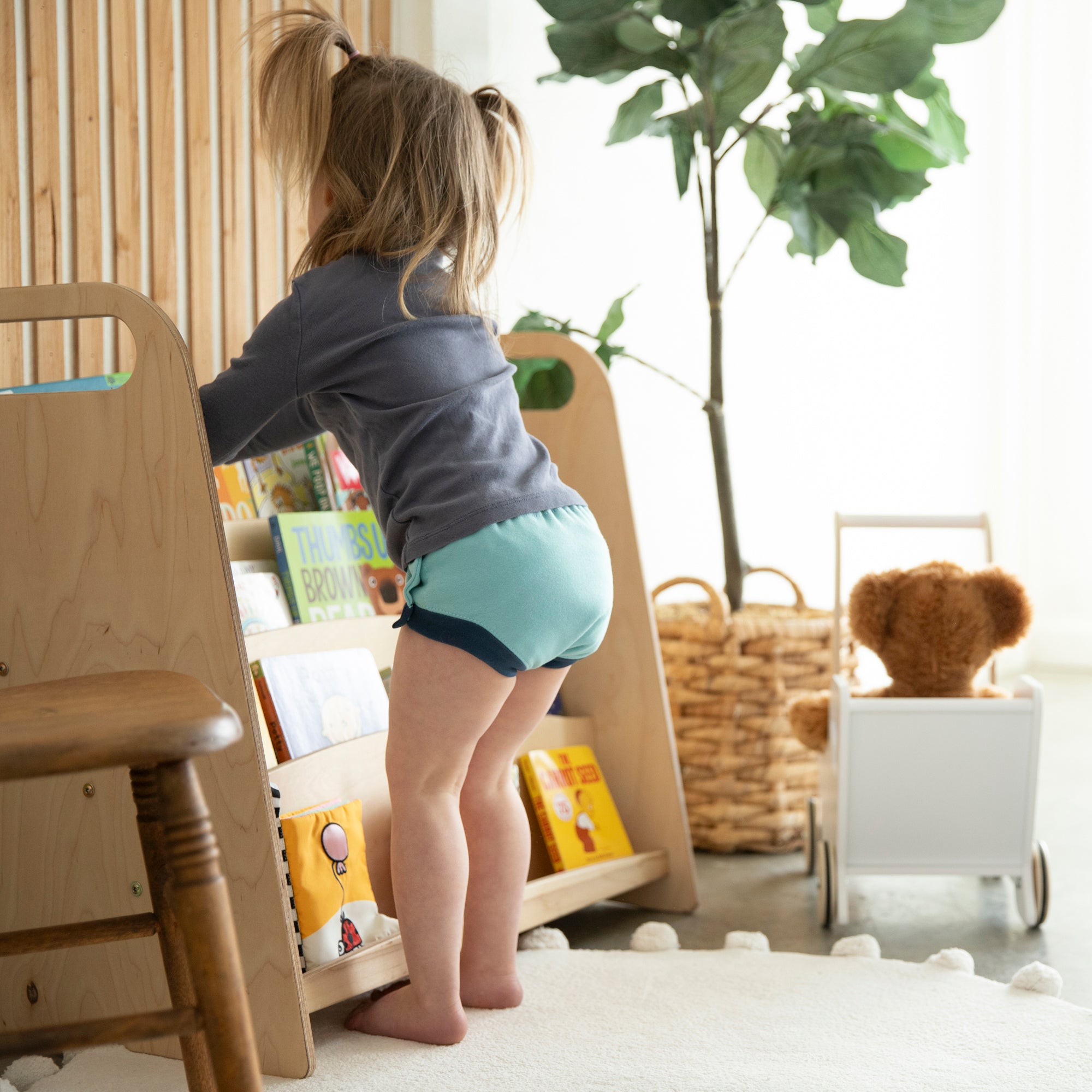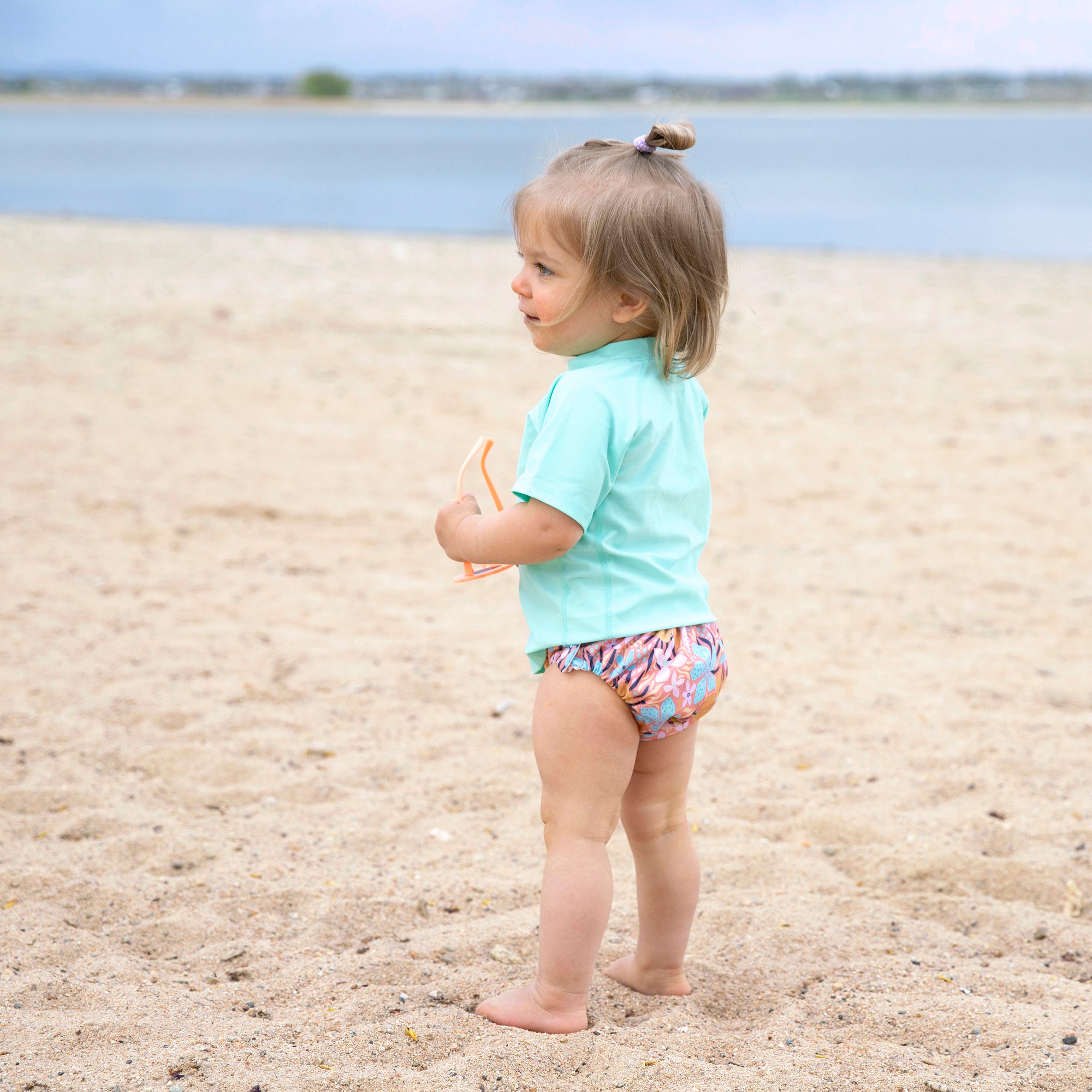One of the most common concerns we hear at our boutique about cloth diapering is that it ‘must be difficult’ to cloth diaper a newborn or that ‘cloth diapers probably won’t fit a newborn baby’. The truth is, cloth diapering a newborn isn’t really that much different than cloth diapering an older baby. The right diaper, a great fit and the right absorbency can completely change your opinion of cloth diapering your newborn. More often than not, parents struggle to cloth diaper their newborn because they are trying to make a system work for them that isn’t truly designed for newborns. Although one size diapers can be great for larger babies, the Thirsties Natural Newborn All In One is truly designed to fit your newborn and cater to the diapering challenges of an infant. In this article, we’ll breakdown some fit tips, fiber facts, prep and care and even troubleshoot some common newborn diapering problems. (Spoiler: No, we can’t make them poop less.) Since fit is pretty much the name of the game with a brand new baby, let’s talk fit tips first.
Fit Tips
The Thirsties Natural Newborn All In One (NNAIO) is different from the other All In Ones in the Thirsties line in that it only has two rise settings (instead of the three seen in the One Size AIO diapers). In other words, choosing your rise setting won’t be too difficult. The fit recommendation for the NNAIO is five to fourteen pounds. Beginning at five pounds, you’ll want to start with the rise settings completely closed and make sure those snaps are adjusted first. Then, you can adjust your waist snaps to the proper setting. Remember that you don’t want to see any gaps between the fabric and baby’s skin, as that can be the cause of leaks in the future. There is also an umbilical cord snap on the front and center snap of this diaper, making it perfect right from birth. Snap the umbilical snap down to give baby’s cord room to heal and unsnap when baby is all healed up. As baby approaches ten pounds, it’s time to let out the rise snaps, unsnap the umbilical snap and give baby room to grow. The same fit checks apply once your rise snaps have been let out too. Make sure to stretch your wings out and then over to get the perfect waist fit and find the proper snaps. When baby’s diaper is fully snapped, you are hoping for a flat fit all the way around. #ThirstiesTip Run your finger along the back waist and inner leg elastic of your newborn diaper. You should have enough room to insert your finger, but no visible space between the diaper and your baby’s skin. If you see a gap, try your fit again by either closing the rise (if you haven’t already) or moving in a waist snap.Fiber Facts
The Thirsties Natural Newborn All In One is made with the same signature hemp/organic cotton blend that you’ll find in the Natural One Size All In One and Duo Hemp Prefolds. There are six layers of 55% hemp/45% organic cotton in the soaker pads, as well as two layers of the same blend in the shell. Although this sounds like a bulky diaper for a newborn, it’s actually one of the trimmest newborn AIOs on the market. The outer shell is made from 100% waterproof TPU laminate, helping prevent leaks. There are also two inches of TPU laminate on the inside of the shell, at the top of the front panel to prevent tummy leaks as well. So, what does all that mean? That means that although this diaper may look trim, it actually has more absorbency than many other newborn diapers and its absorbency is made of completely natural fibers as well. Easy to use, easy to clean, trim to wear. #ThirstiesTip Because the soakers in this diaper are only sewn into the front panel, you can fold your soakers in half to help heavy wetters or tummy sleepers get a little extra absorbency right where they need it. This is yet another benefit of choosing natural fibers.Prep and Care
Before you use any cloth diapering product, there is a certain amount of prep that is required to make sure that your diaper is as absorbent as possible. Hemp products actually take a bit longer to prep than other fibers, but I promise, they are so worth it. To prep your NNAIO, you’ll want to wash and dry your diaper at least three times, using a small amount of cloth diaper safe detergent and making sure to do so separately from your other cloth diapering and laundry items due to the release of oils during prep. Technically, your diapers are now ready to use. However, keep in mind that eight full wash and dry cycles are needed to maximize the absorbency of your Newborn Natural All In Ones. Have I ever cheated and used a diaper before being fully prepped? Yes. And I have also regretted it. Trust me, you will want to fully prep your diapers before introducing them to your newborn. Another common concern we hear regarding cloth diapering newborns is ‘won’t meconium be impossible to wash out?’ when in fact, it’s pretty simple. An exclusively breastfed baby’s waste is water soluble. In other words, toss it right in your washer and run your diaper laundry like normal. If your baby has any formula or supplementation in their diet, their solids will need to sprayed out or removed with a liner before washing in your laundry. It’s that easy. To wash your diapers, start again with a cloth diaper safe detergent and about 18 to 24 Natural Newborn All In One cloth diapers. Start with a pre-wash on WARM and half the amount of recommended detergent. Once this cycle is complete, do a heavy duty wash on HOT with the full amount of recommended detergent. Add a rinse and you’re done. #ThirstiesTip Wash your diapers every other day for the easiest, problem free routine. This will keep your diapers clean and keep mildew, mold or any potential stink issues far away.Troubleshooting
So, you’re cloth diapering your newborn and everything is going great until… they start leaking. Let’s troubleshoot some common cloth diapering problems that will eventually create leaks.- Baby is flooding the front of the diaper. This is a common problem and very easily solvable. Take the soaker pads on your Natural Newborn All In One and fold them in half so that there is double the amount of absorbency in the front panel of your diaper. This will help absorb the extra liquid when flooding occurs and prevent leaks.
- Baby is leaking out the legs of the diaper. Leaking out the legs of your diaper can be one of two issues. If you are having leg leaks, check to make sure that the elastic of the diaper touches baby’s leg when the diaper is secured. Gaps in the leg areas of the elastic will almost always result in leaks. Also, this may mean you need just a touch more absorbency. Try folding a Thirsties Organic Cotton Wipe longways and adding it in as a doubler!
- Baby is leaking out the back waist elastic of the diaper. This type of leak is less common, but it can occur when caregivers are not properly securing the waist snaps. Make sure that your waist snaps are tight enough that your material is touching baby’s skin and there is only room for two fingers to be run around the inside of the waist elastic.



